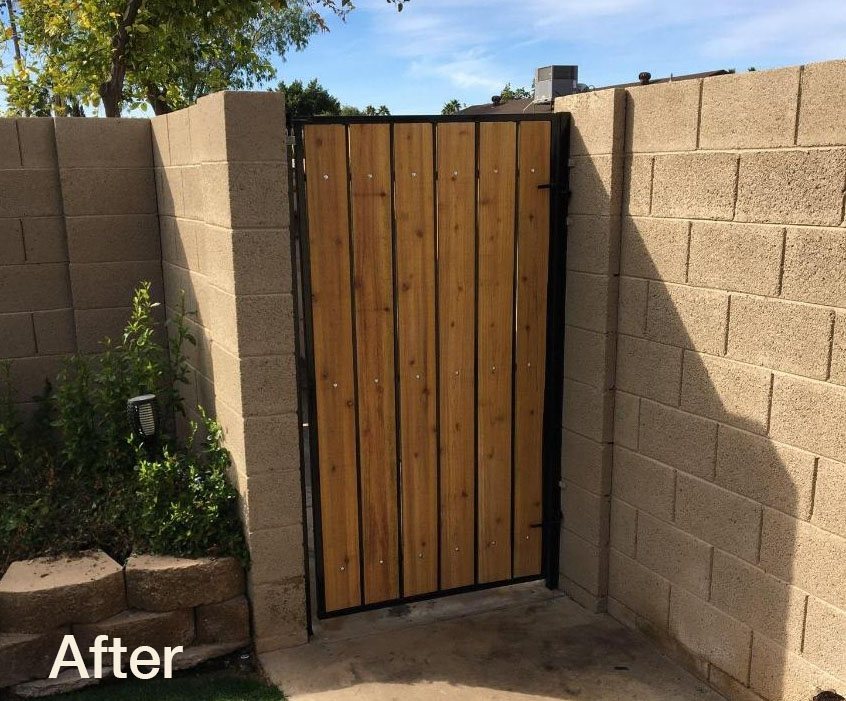Inspecting Your Exterior Gates and Fences
Gates & Fences Can Look Good While Providing Security & Privacy
Gates and fences of course serve the practical purposes of providing security and keeping prying eyes out of your yard. But while you are enjoying the comfort of your own yard, you want to have a nice view yourself.
It's important to inspect your exterior gates and fences regularly to make sure they are in proper working order and will upstand any weather or adverse conditions they may be subject to. The following are tips to help you maintain your gates and fences.
Fences:
Block walls when constructed correctly, provide wonderful privacy, are a great fire barrier, and are resistant to weathering and do not require much maintenance.

The biggest issue with block is the appearance of efflorescence, those granular white stains that show up on block walls when they repeatedly get wet. Block and mortar are both constructed with water that contains calcium. The problem shows up when the walls get wet, pulling the soluble salts and calcium from inside of the block to the outside. Mineral deposits from sprinklers with hard water can also contribute to the problem.
Regardless of how the efflorescence finds your wall the very best solution is to keep water from hitting it. That means you'll want to redirect irrigation away from walls even if that means changing your planting scheme. To help prevent this, coat the top of the wall with a 2-step product called Thoroseal to lessen rain exposure. You can find this product at Rosie Certified Marvel Building & Masonry Supply.
If you already have efflorescence build-up try the following:
- Use a power washer to remove dirt, loose paint and all signs of efflorescence from the walls. For tough spots, add some diluted trisodium phosphate (TSP; find it at any home store) to the power washer's secondary pickup tube
- To take care of the issue by hand, use a cleaning solution of 1-part vinegar to 5 parts water and a stiff nylon brush. You should be able to scrub most of the efflorescence off.
- For stubborn issues try Efflorescence Remover by Glaze and Seal
For preventive measures:
- Paint the wall using a primer first - a single coat of paint will probably not prevent efflorescence build-up. Rather, the efflorescence will merely bleed through the paint and cause additional maintenance. To properly paint a block wall, thoroughly clean and allow to dry completely. Then apply a paint primer coat such as Eff-Stop by Dun Edwards. Be sure to allow time to cure prior to applying the paint.

- Seal the inside of block planters with a waterproof coating like Thoroseal before adding dirt or planting.
- New block walls are best treated with a block fill product. The folks over at Rosie Certified Partner Dave's Adobe Painting mentioned they like Sherwin Williams. For the new block, use a block-fill product and topcoat it with Sherwin Williams SuperPaint.
In addition, do not plant trees too close to your wall. Trees with invasive root systems can also be problematic for the structural integrity of block walls. Planted too close to a wall, the roots can actually raise the wall causing cracks in the mortar joints leading to potential wall failure.
Check with your local nursery when considering planting trees or shrubs close to your wall to make sure the species you have in mind don't have those invasive roots. If you do have a root problem affecting your wall, you should contact a certified arborist and have them come take a look at what may be done to stop further damage.
Gates:
Wood slats: Most gates in Arizona neighborhoods are similar in build, having a metal frame with wood slats. One trick to maintaining these gates is to keep extra pre-stained slats on hand. Replacing them is as easy as using your drill to remove the screws at either end then screwing in the new slat. Consider replacing wood slats with a long-lasting wood alternative like Trex.

Metal frame: If the gate is showing signs of rust give it a fresh look by painting the metal frame. First, remove the slats and sand the metal frame. Protect the surrounding surfaces with drop cloths and give the frames a good coat of rust preventing, metal approved, spray paint, then reinstall the slats.
Is your gate hard to close?
Start by checking the column that the gate is screwed into. It will be either a wood post or a block column. If the column is leaning it will need to be replaced and secured, preferably with a steel or concrete foundation. A block column anchored in a concrete footing will prove to be the most durable. The hinges should be welded to a steel member that will be secured to the column with expansion type anchors.
TIP: One life simplifying upgrade is to replace hinges and latches with a self-closing variety. This tip may also be a requirement if you have a pool. Pool fences must have self-locking gates and be in good repair. Check with your city as to exact code requirements.
September Home Maintenance To-Do | Inspect your exterior #Gates&Fences
###
Photo Credits:
- Rosie on the House
- Homeowner Dan G. of Chandler
RELATED CONTENT:
- Blog: Know the Costs of Maintaining Your Home
- Blog: 5 Ways to Make Your Desert Yard More “Sustainable”
- DIY Q&A: How Can I Protect My Wooden Deck & Patio
- DIY Q&A: Time to Get Ready for a Big Splash Party
- DIY Q&A: Four DIY Projects That Help Pay for Themselves
- DIY Q&A: 15 Quick Fix Repairs to Do This Weekend
- Podcast: 5 Ways To Make Your Desert Yard More “Sustainable”
